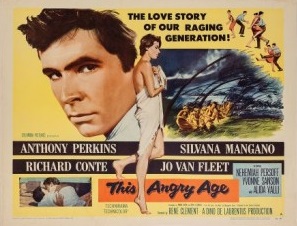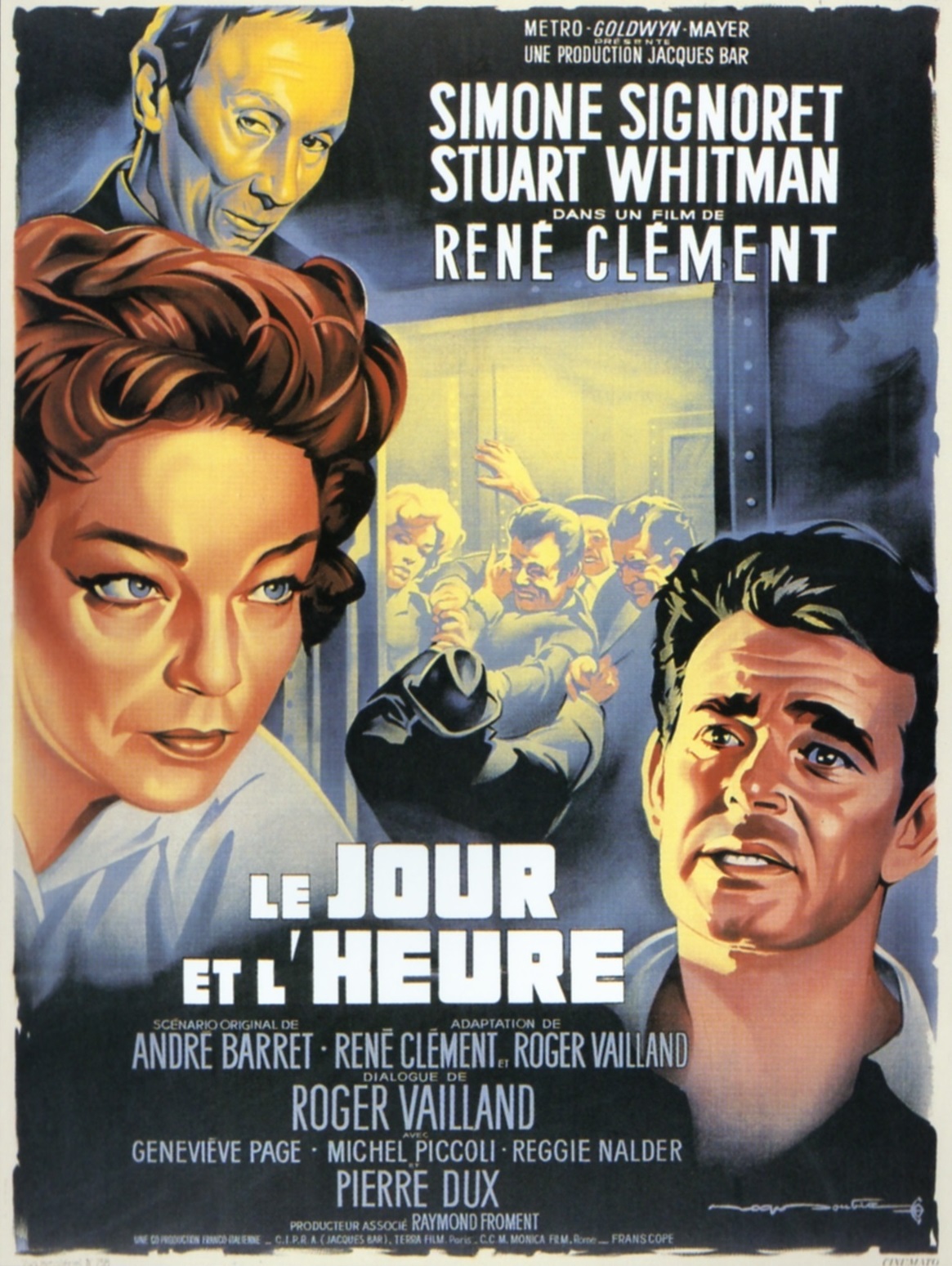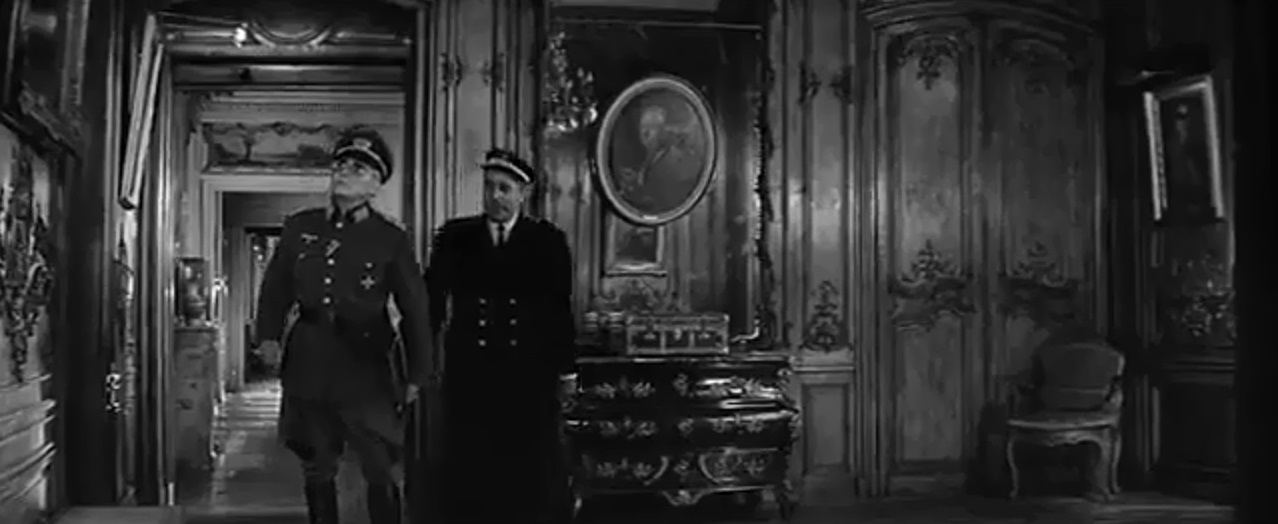Bataille du rail
After the introductory material, the film opens on a sight that
instantly identifies it with the European and the Scandinavian position, a sign
forbidding Jews to enter the occupied zone.
From that point,
the Maquis have their allies among the railwaymen of
Frankenheimer’s The Train, who
risk their lives to impede the Germans at every turn.
Furthermore, it
is a question of communications across the two zones set up by the Germans,
transporting men and mail in secret.
After D-Day (le débarquement),
operations are intensified to prevent reinforcements arriving in Normandy.
On stolen
bicycles and horse-drawn wagons, on foot (and with a last stab at utilizing the
rails), the Germans depart France one and all.
The magnificence
of the resources placed at Clément’s command is no less surprising than
the ease of his mastery, he has all the German soldiers and equipment needed,
trains, tanks, cannon, even an armored train that goes over the side at full
speed.
Le Père tranquille
The chef du groupe in Moissan is a colonel who sells insurance, assurances,
and in his spare time grows notable orchids.
The influence of Wyler’s Mrs. Miniver seems evident, if
possible, and the germ of an idea for Jeux interdits also.
The magnificent technique displayed, indeed lavished effortlessly on
this masterpiece, is pure Clément.
Time Out Film
Guide’s
remark, “overall it’s too tendentious to take seriously,” is
one of the most astounding constructions ever foisted on a work of art.
Le Chateau de Verre
The love of a Switzeress and a Parisian, met
by the sea in Italy.
Paris, “c’est
pas une grande ville,” he tells her in a taxi, “c’est beaucoup de petites
villes.” Cf. Dearden’s The
Bells Go Down.
A hotel in the Palais-Royal, even if the
proprietress says so the elevator doesn’t work.
“An imitation of rigor and elegance,” thought Truffaut.
She’s married to a judge with a most amusing case, the points of
reference are Anna Karenina and Brief Encounter, he’s a traveling salesman...
View from the Pantheon. Score Baudrier, conductor Jolivet. Cinematography Le Febvre. Novel the incomparable Vicky Baum.
Ahead of Monsieur Ripois, Clément dans les rues. Litvak
has Goodbye Again, a remote memory.
Dr. Roman Colbert was asked by a student to explain je vous aime and je t’aime, “before and after,” he said,
thus the Palais-Royal, “now I recognize
it.”
The title is a souvenir d’enfance.
Jean Marais, whose specialty is the tour de force, Michèle Morgan.
Godard and Rivette arrive at the Gare de l’Est.
Jeux interdits
A complete, devastating satire of France in 1940, top-to-bottom, all
the way around. It couldn’t be more absolute if
Daumier had drawn it.
For half a century, it was misunderstood as a childhood sob story or
tract, effectively damning Clément’s subsequent work.
Only John Osborne in England has the same cry of rage tempered by humor
of the best sort on a total disaster.
Monsieur Ripois
It leaves the London office et voilà the New Wave, as Rimbaud
would say.
English girls, Truffaut had his nose in the book and missed them,
crossly, but made l’homme qui aimait les femmes (and, to be sure, Deux
Anglaises et le continent), cf.
Edwards’ The Man Who Loved Women.
Godard might have taken his inspiration from the rainy rendezvous with
Norah for Adieu au langage (Flicker perhaps
remembers it at the end of The Troublemaker, to say nothing of Gilbert
likewise for Alfie).
And does not Schlesinger in Midnight Cowboy remember
Clément’s Hyde Park? The citation from
Wyler’s Carrie is just rounded off to fit nicely, and in this
scene amongst the prostituées one recognizes
Ophuls’ La Ronde, which is what Dali
would say is quite a pirouette (Malle has the “Prince de Galles” in Atlantic City).
The “heteroclite” library of Cadet-Chenonceaux
has Touchez pas au grisbi,
among other things (Queneau’s Le Journal intime de Sally Mara).
Lovers, Happy
Lovers,
“an odd and interesting film” (Bosley Crowther
of the New York Times).
Time Out does not go so far as
to suggest Losey’s The Romantic Englishwoman, but only just.
Mallarmé’s Swan appears in his own right as well as the
poet’s (the critic John Simon is said to have done his thesis on “Hérodiade”), “son pur
éclat...”
“A little Waterloo never killed anyone,” but observe how
close the hero comes, after several arduous and disagreeable conquests, to
winning the fair.
Bresson famously emulates his end in Une
Femme douce, “il
s’immobilise...”
According to Truffaut, “Hémon’s Ripois was a monster, Clément’s is a cynical
buffoon,” for Crowther the latter was
“the lowest form of human heel”, even
worse than Pal Joey.
This
Angry Age

How ya gonna keep ‘em
down on the farm after they’ve seen Bangkok?
A firm called Legros makes a bid on the
place, Legros fils
for the daughter.
The son makes bold to leave, the sea wall breaks, a lover is stranded, he recommends concrete.
A lady whose paramour drinks and falls asleep at the cinema, not
“following the affair” (an American crime drama, Yankee culture gets
a ribbing).
The lover is a disgraced merchant mariner, blamed for a shipwreck.
The brother returns home, the man of the house. The
sister departs for Portugal with the lover, construction work.
Cocteau’s Les Parents terribles and Les Enfants terribles (dir. Jean-Pierre
Melville) figure visibly in the
composition.
The typhoon is rather like John Ford’s Hurricane,
Clément’s greatest effect is simply an impromptu lunch on the river.
Bosley Crowther of the New York Times,
“there is considerable truth in this film, if you
care to look for it.” Leonard Maltin,
“ludicrous mishmash”. TV
Guide, “to no avail”. Halliwell’s
Film Guide, “moments of interest and even beauty.”
Plein soleil
The title means “full sunlight”, though in English it is
heightened as Purple Noon, and suggests among other things George
Stevens’ A Place in the Sun. The plot developments
more closely resemble Richard III, Olivier’s film is certainly a
memory of the war. These are the steps by which the
level of thought in Clément’s film is comprehensively obtained.
His remarkable steadiness of nerve has been noted, along with a
resemblance to Clouzot in Les Diaboliques on that account,
relieved by a kind of diabolical humor.
Everything has been hammered out to beaten gold,
the sense of refinement is a long clear look in the light of day.
Quelle joie de vivre
Clément has seen and admired Joannon’s Utopia
with Laurel and Hardy, evidently.
It gives him a basis on which to examine anarchists (“libre totalement volontairement solitairement libre”) and blackshirts
strictly from hunger in Rome at the start of the Twenties (cf. Bolognini’s Libera,
amore mio... ).
“Qu’est-ce que
c’est que la liberté, hein?”
“Mais la liberté
c’est, euh, pas aller en prison.”
“C’est lamentable.”
Le Trou Sylvestre, from Becker. The exquisitely refined technique serves in a comic mêlée
and at the setting of the anarchist bombs as well. Ulysses
the Spanish graveyard and his exploding cauliflower. The
magic lantern show from Shoeshine (dir. Vittorio
De Sica). The title song in a Roman ristorante (“Che
gioia vivere”). The arrival of the generals from the Four Powers.
Fascist tools at the Foire de la Paix ahead of Dearden’s The Assassination
Bureau and Friedkin’s Deal of the Century (cf. Gilliat’s Left Right and Centre for the
structure overall).
Homage to Piranesi.
The
Day and the Hour

Occupied France. “The war doesn’t
interest me.”
“Aren’t you interested in the fact that we’re defending
you against Communists, plutocrats and the Jews?”
“No.”
Two slaps. “And that—that interest
you?”
Cf. Asquith’s The
Yellow Rolls-Royce. “Who is to be the big
hero, you or me?” The “Swede, lives in Montparnasse, a painter, he had a show in New York,”
is of course Max von Sydow in Hannah and Her
Sisters (dir. Woody Allen). Bombed in Paris
playing Louis’ blues (Au Revoir les enfants, dir. Malle), drunk as James Dean. Losey has Mr. Klein, Rossellini a certain General Della Rovere, Clément “the famous Sophie” in the
hands of the French police who want one Titus (cf. Cassavetes’ Gloria,
or Lumet’s). “In the Gestapo they have the
latest scientific methods.” Partisans, O.S.S.,
Spain, D-Day.
Howard Thompson of the New York Times, who found the romance not
to his liking just as a predecessor of his objected to Dassin’s Reunion
in France, “reflects the visual wizardry
of the director.” Hal Erickson (Rovi)
speaks of “fellow undergrounders” and
does the lady a disservice.
Andrew Sarris in The American Cinema (“his two best
films—Lovers, Happy Lovers and This Angry Age—were
both English-language productions”) makes a point of not admiring it (Is
Paris Burning? he calls “disastrous dullness”), with Signoret
and Whitman in the dub.
Joy House
Like The Big Sleep, a marriage fantasy, but not a film noir,
though the flashlight scene is a joke on this.
The structure is punctuated with hallucinatory jokes, a cast-iron key
ninety years old and big as your forearm down a lady’s front for
safekeeping without a blink, an infuriated motorist on two wheels who lands on
all four and remonstrates, the woods are full of them.
An affair with a gangster’s moll, then on the lam at Villefranche-sur-Mer with a widow and her lover and her
cousin in a mansion “neo-Gothic”.
A close precedent for Altman’s That Cold Day in the Park. “Dismal claptrap,” said Howard Thompson (New
York Times), “pure, pretentious baloney,” a close precedent for
John Simon’s review of the Altman.
Is Paris Burning?

“My God. Gentlemen, you have heard which way the wind’s
blowing.” The great division in the main factions of the
Resistance is dealt with briskly, Catholic Youth meet Young Communists in a
Gestapo trap. The screenplay is thus most economical,
and yet lavish in its beauty and precision. “Brad,”
says Kirk Douglas as Gen. Patton just apprised of events there, “what the
hell’s going on in Paris?” He’s on a
field phone to Gen. Bradley, a brave Resistance fighter has traveled to the
Normandy front with news, crossed the lines and been led to Patton in his tent
(Douglas evokes Patton without mimicry, an heir of Grant).
The city is mined on Hitler’s personal order. The German officer who receives this order knows the
Führer is mad, nevertheless the charges are laid. Resnais’
Von Choltitz figures in On Connait la Chanson. The
example given in a German newsreel is Warsaw, “it was here that the
Polish terrorists first fired on German troops... a lesson not only to the
Poles, but to the world... Warsaw no longer exists,
and it will never exist again.”
Orson Welles appears as Swedish consul Nordling
in the film’s great set-piece on the Occupation regime.
It plays from the Hotel Meurice by Dantean degrees to the train platform for Buchenwald,
ending with a Daumier tracking shot in the rain.
Belmondo takes the Matignon by force
of character, Cassel storms the Meurice where Fröbe dallies, Montand fights a
tank duel on the Place de la Concorde, and so forth. There
were cameramen in Paris, they shot footage Clément
makes use of.
The title (Paris brûle-t-il?)
is asked in German (Brennt Paris?) over
the telephone from Rastenburg or Berlin in an effort
to determine whether or not Hitler’s orders are being carried out, while
bells are pealing and the lights come back on.
It stands to reason that such a history would require an
extraordinary film for its depiction, and it stands equally that the critics
were utterly unable to receive it.
Bosley Crowther of the New York Times could not follow it at
all, “it leaves one exhausted and irked... do you wonder you’re
likely to burn?” Time Out, “has scarcely improved with age.”
TV Guide, “a fairly
entertaining, action-packed film which seems continually in danger of
collapsing under the weight of its own pageantry.” Hal
Erickson (All Movie Guide),
“seems more weighted down than weighty.” Halliwell’s Film Guide,
“muddled, scribbled, tedious and confusing attempt at a thinking
man’s all-star war epic.”
Le Passager de la pluie
Clément now, naturally, looks at France resisting, twenty years
after Jeux interdits
and ten after Plein soleil. She is hard to find, hard to discern, hard to explain.
But there she is in all her glory à la Mrs. Miniver,
raped, revenged, plucked out of an angry whorehouse, restored to home and
hearth.
All Movie Guide has it “confounding the audience at
every turn,” Time Out Film Guide adds “glossy direction from
Clément” as a consolation.
Tony Mastroianni of the Cleveland Press, who always sits
on his hands, brought them up to applaud Rider on the Rain “like
the Hitchcock films of yesteryear,” to be sure, “not the recent
Hitchcock.”
La
Maison sous les arbres

A very celebrated journey by barge canal (L’Atalante, dir. Jean Vigo). Que diable allait-elle faire dans cette galère?
After Le Passager de la pluie, the
question is how or why. One is not rich but well-off, dealing in images,
probability and statistics, wife has a psychiatrist and a memory problem...
A considerable light is thrown on Furie’s The Naked Runner.
Clément throws everything into consideration, but everything,
properly. The result from its first frames is one of
the great works of the cinema.
The offer, when it comes, is after the manner suggested by
Becker in Touchez pas au grisbi,
a contract... The
Deadly Trap. The pivotal image is from Ken Russell
on Isadora Duncan, the Biggest Dancer in
the World. The works of Jean-Pierre Melville may profitably be consulted. Tout simple, Resnais presents the job offer in Vous n’avez encore rien vu, from Mon oncle
d’Amérique. Americans in Paris, later on it’s Frantic (dir. Roman Polanski)...
M. le Commissaire asks dispassionately
if she has thoughts of suicide. Forbidden
Games in a simultaneous perspective, as it were. Consequences naturally for
La Baby Sitter... and in the present
instance from Thérèse Desqueyroux
(dir. Georges Franju).
If you like, a simple case of kidnapping for industrial
espionage, though Vincent Canby of the New
York Times had doubts, “all of it is so arbitrarily muddled you begin
to believe the film means to demonstrate other things... nothing really works, though.” Halliwell’s
Film Guide is the very definition of arbitrary muddling, “smoothly
made thriller which spends rather too much time being chic.”